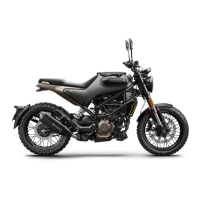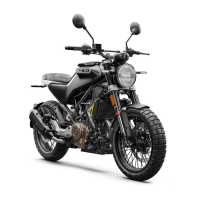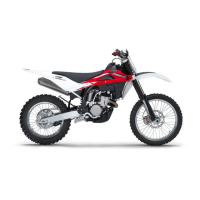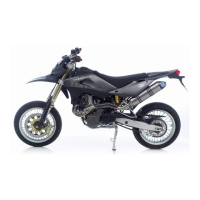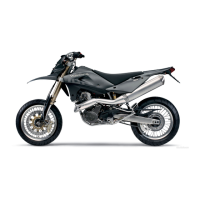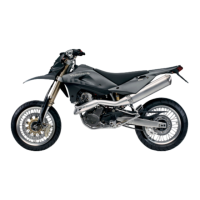Why aren't the headlight and position light working on my Husqvarna Motorcycle?
- AallisoncrystalSep 9, 2025
If the headlight and position light are not functioning on your Husqvarna Motorcycle, it is likely due to a blown fuse 6. Replace the fuse.
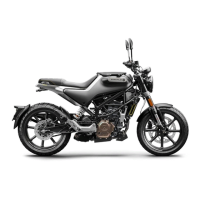
Why aren't the headlight and position light working on my Husqvarna Motorcycle?
If the headlight and position light are not functioning on your Husqvarna Motorcycle, it is likely due to a blown fuse 6. Replace the fuse.
Why are the turn signal, brake light and horn not working on my Husqvarna Motorcycle?
If the turn signal, brake light, and horn are not functional on your Husqvarna Motorcycle, it's likely due to a blown fuse 4 or 6. Replace the fuse.
Why is the time wrong or not showing on my Husqvarna Motorcycle?
If the time is not displayed or not correctly displayed on your Husqvarna Motorcycle, it is likely due to a blown fuse 2 or 7. Replace the fuse.
| Brand | Husqvarna |
|---|---|
| Model | SVARTPILEN 200 2022 |
| Category | Motorcycle |
| Language | English |
Explains symbols used in the manual for clarity and warnings.
Describes typographical conventions used throughout the document.
Defines the vehicle's intended use and warns against misuse.
Provides fundamental safety advice and emphasizes reading the manual.
Explains hazard levels and associated symbols for user safety.
Stresses the importance of protective gear and outlines rules for performing work on the vehicle.
Covers manufacturer warranty, service importance, and customer support channels.
Advises on proper fuel usage and the importance of approved spare parts.
Identifies key components from the front-left perspective of the motorcycle.
Identifies key components from the rear-right perspective of the motorcycle.
Explains where to find the VIN and engine serial numbers for vehicle identification.
Indicates where key numbers and component article numbers are located.
Details the function of levers, grips, and switches on both handlebars.
Covers operation of the ignition switch, steering lock, and seat lock.
Explains operation of fuel cap, tool set, grab handle, foot pegs, and brake/shift levers.
Details the function and safety implications of the side stand.
Introduces the combination instrument, its activation, and self-test features.
Explains various warning messages and indicator lights displayed on the instrument panel.
Describes display content like fuel, coolant, and trip data, and navigation via buttons.
Covers adjusting ABS modes and setting measurement units for display.
Details how to set engine speed thresholds for the shift warning light.
Provides essential advice for initial use, including safety and engine break-in.
Outlines safe practices and limits for loading luggage and passengers.
Lists critical checks before riding and the procedure for starting the engine.
Offers guidance on gear shifting, cornering, and proper brake application.
Explains safe methods for stopping, parking, and refueling the motorcycle.
Lists mandatory maintenance work and their intervals for vehicle longevity.
Outlines recommended tasks for optimal performance and wear prevention.
Guides on adjusting the rear shock absorber's spring preload for rider preference and load.
Explains how to adjust the handlebar mounting for improved ergonomics.
Details procedures for safely lifting the motorcycle using front and rear lifting gears.
Covers removal and installation of side covers, seats, and the bag carrier.
Guides on removing and installing the license plate bracket and front spoiler.
Explains checking and adjusting the drive chain tension and inspecting components.
Explains the ABS function, safety warnings, and troubleshooting indicators.
Covers checking brake discs for wear and maintaining brake fluid levels.
Details inspection and adjustment procedures for brake linings and levers.
Provides steps for removing and installing the front and rear wheels.
Guides on checking tire condition, tread depth, and maintaining correct pressure.
Explains battery removal, installation, and charging procedures with safety precautions.
Covers changing main, ABS, and individual electrical component fuses.
Details headlight aim adjustment and the location of the diagnostics connector.
Guides on checking the coolant level and antifreeze concentration.
Explains procedures for draining, filling, bleeding, and changing the engine coolant.
Covers checking and adjusting the free play in the clutch lever for proper operation.
Details how to check and adjust the basic position of the gear shift lever.
Provides instructions for checking, adding, and changing engine oil and the oil filter.
Offers guidelines and precautions for washing the motorcycle.
Outlines specific checks and care for the motorcycle during winter conditions.
Details the steps required to prepare the motorcycle for extended storage.
Guides on recommissioning the motorcycle after a period of storage.
Addresses common problems related to engine starting, power, and stalling.
Covers troubleshooting for electrical faults, warning lights, and instrument display problems.
Lists detailed engine, chassis, brake, and suspension specifications.
Provides torque values for fasteners and fluid capacities for engine and cooling systems.
Lists specifications for the electrical system, tires, fork, and shock absorber.
Specifies the types and standards for brake fluid and coolant.
Details recommended engine oils and fork oil types.
Outlines the required fuel type, octane rating, and ethanol content limits.
Lists recommended products for cleaning and lubricating the drive chain.
Recommends products for cleaning, polishing, and protecting the motorcycle.
Explains industry standards for engine oils related to performance and viscosity.
Defines key technical terms used within the manual.
Provides a list of abbreviations found in the manual with their meanings.
Explains the meaning of yellow/orange warning symbols and green/blue informational symbols.
